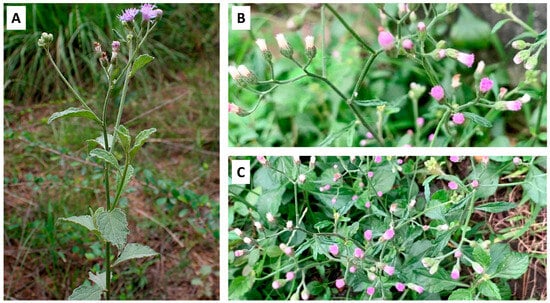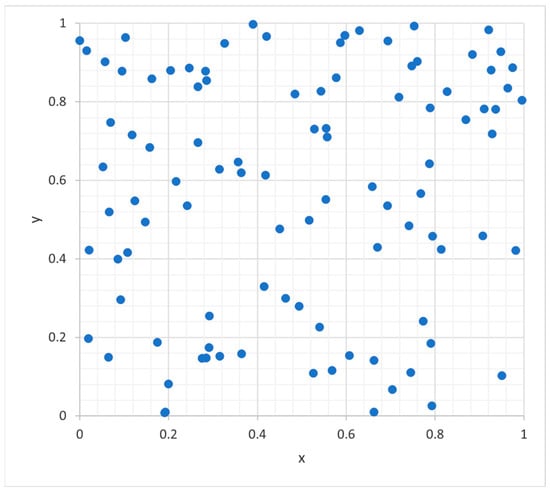Vernonia cinerea (L.) Less. is a perennial herbaceous plant found mainly in tropical areas, particularly in Southeast Asia, South America, and India. Various parts of
V. cinerea have traditionally been used in folk medicine to treat several diseases, such as malaria, fever, and
[...] Read more.
Vernonia cinerea (L.) Less. is a perennial herbaceous plant found mainly in tropical areas, particularly in Southeast Asia, South America, and India. Various parts of
V. cinerea have traditionally been used in folk medicine to treat several diseases, such as malaria, fever, and liver diseases.
V. cinerea has so far yielded about 92 secondary metabolites. The majority of these are sesquiterpene lactones, but triterpenes, flavonoids, steroids, phenolics, and other compounds are present as well.
V. cinerea crude extracts reportedly exhibit anti-inflammatory, antiprotozoal, antidiabetic, anticancer, antimicrobial, antioxidant, and renoprotective activities. This study aims to provide the latest up-to-date information on the botanical characterization, distribution, traditional uses, phytochemistry, and pharmacological activity of
V. cinerea. Information on
V. cinerea was thoroughly reviewed. The literature published between 1950 and 2024 was compiled through online bibliographic databases, including SciFinder, Web of Science, Google Scholar, PubMed, ScienceDirect, Springer Link, Wiley, and the MDPI online library. The keywords used for the literature search included
Vernonia cinerea (L.) Less. and the synonyms
Cyanthillium cinereum (L.) H.Rob.,
Conyza cinerea L., and various others.
Full article
 IJMS
IMPACT
IJMS
IMPACT Applied Sciences
IMPACT
Applied Sciences
IMPACT Sustainability
IMPACT
Sustainability
IMPACT Sensors
IMPACT
Sensors
IMPACT JCM
IMPACT
JCM
IMPACT Materials
IMPACT
Materials
IMPACT Molecules
IMPACT
Molecules
IMPACT Energies
IMPACT
Energies
IMPACT Electronics
IMPACT
Electronics
IMPACT Remote Sensing
IMPACT
Remote Sensing
IMPACT Cancers
IMPACT
Cancers
IMPACT Nutrients
IMPACT
Nutrients
IMPACT Mathematics
IMPACT
Mathematics
IMPACT Foods
IMPACT
Foods
IMPACT Buildings
IMPACT
Buildings
IMPACT Polymers
IMPACT
Polymers
IMPACT Animals
IMPACT
Animals
IMPACT Water
IMPACT
Water
IMPACT Plants
IMPACT
Plants
IMPACT Agronomy
IMPACT
Agronomy
IMPACT Biomedicines
IMPACT
Biomedicines
IMPACT Processes
IMPACT
Processes
IMPACT Microorganisms
IMPACT
Microorganisms
IMPACT Diagnostics
IMPACT
Diagnostics
IMPACT Nanomaterials
IMPACT
Nanomaterials
IMPACT Viruses
IMPACT
Viruses
IMPACT Medicina
IMPACT
Medicina
IMPACT Healthcare
IMPACT
Healthcare
IMPACT Cells
IMPACT
Cells
IMPACT Forests
IMPACT
Forests
IMPACT Agriculture
IMPACT
Agriculture
IMPACT Land
IMPACT
Land
IMPACT JMSE
IMPACT
JMSE
IMPACT IJERPH
IJERPH
 Symmetry
IMPACT
Symmetry
IMPACT Genes
IMPACT
Genes
IMPACT Pharmaceutics
IMPACT
Pharmaceutics
IMPACT Coatings
IMPACT
Coatings
IMPACT Micromachines
IMPACT
Micromachines
IMPACT Pharmaceuticals
IMPACT
Pharmaceuticals
IMPACT Atmosphere
IMPACT
Atmosphere
IMPACT Children
IMPACT
Children
IMPACT Religions
IMPACT
Religions
IMPACT Antioxidants
IMPACT
Antioxidants
IMPACT Life
IMPACT
Life
IMPACT Metals
IMPACT
Metals
IMPACT Biomolecules
IMPACT
Biomolecules
IMPACT Vaccines
IMPACT
Vaccines
IMPACT Education Sciences
IMPACT
Education Sciences
IMPACT Minerals
IMPACT
Minerals
IMPACT Horticulturae
IMPACT
Horticulturae
IMPACT Brain Sciences
IMPACT
Brain Sciences
IMPACT JPM
IMPACT
JPM
IMPACT Bioengineering
IMPACT
Bioengineering
IMPACT























